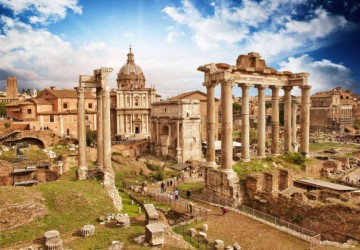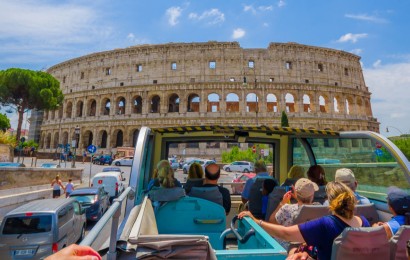Walking in the center of Rome you will come across some remains that are part of the ancient history of Rome: the Roman Forum.
If you are interested in the glory of ancient Rome you can not miss our Guided Tour of the Colosseum and Fori Imperiali with skip the line tickets.
We will start with a wonderful tour to discover the Colosseum, the symbol of Rome and continue with an exciting journey to the archaeological site of the Roman Forum. In this article you will find useful information about the Roman Forum and discover its history and its beauties.
When the Roman Forum was born and what is
The Roman Forum is an archaeological area of Rome consisting of buildings and monuments that represented the center of the political and social life of the ancient city of Rome. Its origin dates back to the seventh century BC, when the area was a swamp that stretched between the hills of the Capitol and the Palatine. Initially it was used as a necropolis of the first villages in the hills.
Over the following centuries, the area was reclaimed with the establishment of the Cloaca Maxima at the behest of King Tarquinius Priscus. It became the center of Roman public life, with the construction of temples, basilicas, courts, triumphal arches, and other public buildings.
The Roman Forum reached its maximum extent and splendor during the period of the Roman Republic. However, with the Roman Empire, the city began to shift its center of gravity towards the Colosseum and other arenas, and the Roman Forum gradually began to lose its importance. After the sixth century AD, the area was abandoned and remained buried under debris until the Renaissance, when it began its excavation and restoration. Today it is together with the Colosseum and the Palatine, one of the most visited archaeological sites in the world.
What to see at the Roman Forum
To visit the Roman Forum will take about an hour.
Here are some of the highlights worth visiting during a visit to the Roman Forum:
- The Temple of Saturn: a large temple dedicated to the god Saturn, located at the entrance of the Roman Forum.
- The Lapis Niger: the area that according to the legend was the place of the death of Romulus and in which the oldest known Latin inscription was found and essential for the study of the evolution of the Italian language and writing
- The Arch of Septimius Severus: a large triumphal arch built to commemorate the victories of Emperor Septimius Severus.
- The Basilica of Maxentius: a large basilica built by Emperor Maxentius, which was used for judicial and administrative purposes.
- The Temple of Antoninus and Faustina: a temple built in the second century in honor of the emperors Antoninus Pius and Faustina.
- The Curia Iulia: the building where the Roman Senate met for administrative and governmental decisions.
- The Arch of Titus: A triumphal arch built to commemorate Titus' victory in the Jewish War. The Temple of Vesta: a temple dedicated to the goddess Vesta, guardian of the sacred fire.
- The House of the Vestals: the building in which the Vestal Virgins lived, the priestesses who took care of the sacred fire of Vesta.
What is the difference between the Roman Forum and the Imperial Forums?
The Roman Forum and the Imperial Forums are two archaeological sites located both in the center of Rome but representing two complexes of ruins and remains of different eras.
The Roman Forum was built in the 7th century B.C. and was the political and social center of Rome for many centuries. Public activities, religious ceremonies and commercial activities took place here.
The Imperial Forums, instead, are a series of forums built by the different Roman emperors between 46 BC and 113 A.D. located north of the Roman Forum. These forums were built to celebrate the military conquests, to exhibit the works of art and statues of the different emperors, and to build monuments in their honor. Among the most famous Imperial Forums are the Forum of Augustus (2 BC), the Forum of Nerva (98 AD), the Forum of Trajan (112-113 AD).
How to access the Roman Forum
To access the Roman Forum, you must be in possession of an entrance ticket. The entrance ticket includes access to the Roman Forum, the Colosseum and the Palatine, and can be purchased in advance or at the ticket office of the site.

